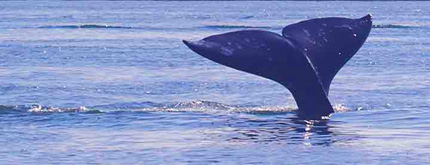
Gray Whales: Nomads of the Sea
By Steven Harper
It felt like meeting an alien creature from another world. I stood in wonder looking out over the sea from a Big Sur precipice as these enchanting giants steadily moved south in their fluid weightless world. It was my first time to see a whale, and not only could I see the plumed spout of each breath, but I could also hear the explosive burst of each exhale as they rhythmically crested for each new breath. Finally, they gracefully lifted their massive tails and dove leaving only silence as I looked on in quiet awe.

Later I learned that I had witnessed gray whales on what is believed to be the longest migration of any mammal. They were on their annual journey south to their breeding and calving ground in Baja California Mexico. They pass off the coast of Big Sur again as they return north toward their feeding ground in the Arctic Ocean. Some years after this first sighting I followed the grays to both their Mexican and Arctic habitat where I have spent a total of many months watching and sometimes interacting with these incredible creatures.
Gray whales of the eastern Pacific spend the summer months from April to October in the Bering, Chukchi, and Beaufort Seas feeding on small crustaceans they sieve from the bottom of the sea floor. These baleen whales are believed to eat as much as 1 ton per day to add the 9 to 12 inches of blubber that is necessary to sustain their lengthy migration. They travel southward October through February swimming day and night covering a 100 miles as day all the while mostly fasting. They stay the winter months on both sides of the Baja Peninsula and near the coast of mainland Mexico. Pregnant mothers use the protected warm water of lagoons and bays to give birth to their young. Young whales can nurse 50 gallons of fat-rich milk a day gaining up to 70 pounds in a single day. These same lagoons and still waters are also used for mating. Often two males and one female can be seen in courtship behavior. When they mate, one male will sometimes support a female as another copulates with her.
They begin the two to three month northbound journey in January in two waves of departure and can be seen off the coast of Big Sur as late as May. The first group to leave Mexico often includes juveniles, males, and females that did not give birth. The second wave includes the mothers with their young and ailing or older individuals.
Scientists believe that 30 to 60 million years ago a group of land mammals returned to the sea. Over the course of time and environmental change the order Cetacea evolved into what we now know as whales and dolphins. While native peoples of the north hunted whales, the peoples of the south opportunistically used whales that washed up. With the discovery of their calving waters whalers hunted the gray whales to the edge of extinction in the mid 1800’s and again in the early 1900’s with the introduction of factory ships. In 1947 the gray whales were given full protection and have become one of the finest examples of how protection can save a species from the brink of extinction. Many scientists believe the eastern Pacific population is close to its original numbers.
Although unlikely to see, the most impressive event I have witnessed in Big Sur was observing a pod of orca whales take a gray whale and the ensuing two-hour red water feeding frenzy. While in the Big Sur take a moment to look seaward. Even if you don’t see a whale you’ll find something—expansive blue water, a wave, a moment that will inspire you—perhaps a moment of quiet awe.
What to look for in Big Sur
First off, if you are driving, pull off the road. Almost any pullout, restaurant, or trailside ocean view will do as long as it is not too close or far from the sea (50 to 500 feet elevation). A calm, windless day is optimal as white caps make it next to impossible to pick out a spout. November through April are the best months for whale watching in Big Sur.
Spouting: spouts of water and vapor form a whitish plume from each exhale. A migrating whale has a predictable sequence of 3-5 breaths in 20-40 second intervals
Sounding: when a whale raises its flukes (tail) to dive. Usually observed at the end of a cycle of breaths. The whale will often stay submerged for 3 to 5 minutes before it next cycle of breaths.
Breaching: Two-third or more of the whales body comes straight out of the water, pivots, and splashes back on its side.
Gray Whale Essentials
• Scientific name: Eschrichtius robustus
• Size: 35-50 feet (females are generally somewhat larger than males)
• Weight: 30-40 tons (60,000 to 80,000 pounds!)
• Color: dark gray with white mottling caused primarily by scaring and barnacles
• Fins: 2 pectoral fins 4 to 5 feet
• Flukes: flukes (tail) are 10 to 12 feet across
• Blowholes: 2 oblong in shape and about 8 inches long
• Dorsal Ridge: two thirds of the way back is a dorsal hump followed by 6 to 12 smaller humps or “knuckles” along the ridge
• Age: 40 to 50 years up to 60
• Speed: 2-6 mph and up to 11 mph in short bursts
• Diet: small crustaceans; amphipods (small shrimp-like krill)
• Reproduction: sexual maturity is reached around 6-10 years with a gestation period of about 12 to 13 months
• Population: estimates vary from 15,000 to 23,000
• Migration: 10,000 to as much as 14,000 miles round trip each year, taking 2-3 months each direction.
copyright Steven Harper all rights reserved